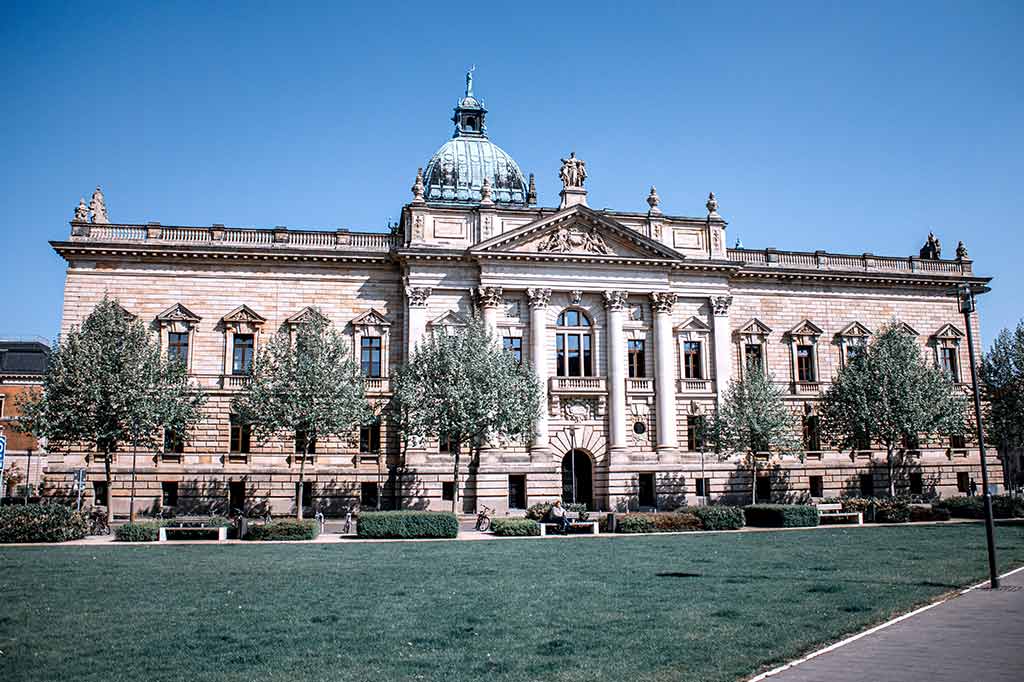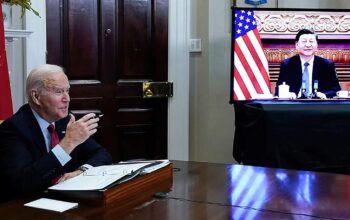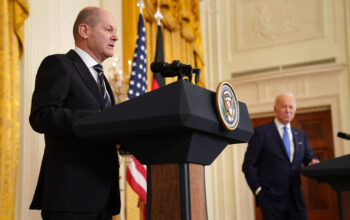Analysis of Structure and Economy of the German Government. Photo Courtesy – Vecteezy
What is the structure of the German government?
The structure of the German government is as follows:
Federal President (Bundespräsident): The head of state, a largely ceremonial role, who represents Germany domestically and internationally.
Federal Chancellor (Bundeskanzler): The head of government, responsible for executive functions and running the administration. The Chancellor is usually the leader of the majority party in the Bundestag (the lower house of the German Parliament).
Federal Cabinet (Bundesregierung): The executive body composed of federal ministers, appointed by the Chancellor, who head various government departments and agencies.
Bundestag (German Parliament): The lower house of the bicameral German Parliament, responsible for passing laws, budgetary decisions, and controlling the government. Members of the Bundestag are elected by the citizens of Germany through a mixed-member proportional representation system.
Bundesrat (Federal Council): The upper house of the German Parliament, representing the 16 federal states (Bundesländer). It participates in the legislative process, especially on matters affecting the interests of the states. Each state has a certain number of votes based on its population.
Federal Constitutional Court (Bundesverfassungsgericht): The highest court in Germany, responsible for interpreting the constitution and ensuring the constitutionality of laws and government actions.
It’s important to note that Germany is a federal parliamentary republic, meaning that power is shared between the federal government and the individual states, with the federal government having authority over certain areas such as foreign policy, defense, and monetary policy, while states have control over education, law enforcement, and cultural matters within their borders. The system is designed to maintain a balance of power between the central government and the states.
Read: China is increasing its nuclear arsenal
How often do elections occur in Germany?
Elections in Germany occur at various levels of government, and their frequency depends on the specific type of election. Here are the most common types of elections and their typical intervals:
Federal Elections (Bundestagswahl): These elections are held every four years to elect members of the Bundestag, the lower house of the German Parliament. The Chancellor is usually the leader of the majority party or coalition in the Bundestag. The last federal election was held in 2021, so the next one would be expected in 2025.
State Elections (Landtagswahlen): Elections to the state legislatures (Landtage) are held every five years in the 16 federal states of Germany. Each state has its own election schedule, so the dates can vary. State elections are crucial for the composition of the Bundesrat, as the members of the Bundesrat are representatives appointed by the state governments.
Germany is divided into 16 federal states, also known as Bundesländer. Here are their names:
(1)Baden-Württemberg, (2) Bavaria (Bayern), (3) Berlin, (4) Brandenburg, (5) Bremen, (6) Hamburg, (7) Hesse (Hessen), (8) Lower Saxony (Niedersachsen), (9) Mecklenburg-Western Pomerania (Mecklenburg-Vorpommern), (10) North Rhine-Westphalia (Nordrhein-Westfalen), (11) Rhineland-Palatinate (Rheinland-Pfalz), (12) Saarland, (13) Saxony (Sachsen), (14) Saxony-Anhalt (Sachsen-Anhalt), (15) Schleswig-Holstein, (16) Thuringia (Thüringen).
European Parliament Elections: These elections are held every five years to elect Members of the European Parliament (MEPs) from Germany. The European Parliament elections are synchronized across the European Union member states.
Local Elections: Local elections, such as municipal and city council elections, are held periodically at the local level. The exact frequency and timing of local elections can vary depending on the state and local government rules.
It’s important to note that circumstances such as early parliamentary dissolution or other political developments might lead to deviations from these general schedules.
How many parties are enlisted in the German constitution?
The German Constitution, also known as the Basic Law (Grundgesetz), does not specifically list or enumerate political parties. Instead, it guarantees the right to form political parties as part of the broader protection of freedom of association.
Article 21 of the German Basic Law states:
(1) “Political parties shall participate in the formation of the political will of the people. They may be freely established. Their internal organization must conform to democratic principles. They must publicly account for the sources of their funds and for their assets.”
(2) “Parties that, by reason of their aims or the behavior of their adherents, seek to undermine or abolish the free democratic basic order or to endanger the existence of the Federal Republic of Germany shall be unconstitutional. The Federal Constitutional Court shall decide on the question of unconstitutionality.”
This means that political parties are free to form and participate in the political process, as long as they adhere to democratic principles and do not seek to undermine the democratic system or the existence of the Federal Republic of Germany.
Germany has a multi-party system, with several political parties represented at different levels of government. The most prominent parties include the Christian Democratic Union (CDU), the Social Democratic Party (SPD), the Free Democratic Party (FDP), Alliance 90/The Greens, and the Alternative for Germany (AfD), among others. However, the specific number of parties and their influence can vary over time due to political developments, elections, and changing public opinions.
A comparison between American and German government structures:
Here’s a comparison between the government structures of the United States and Germany:
1. System of Government:
United States: The United States has a federal system of government, where power is divided between the federal government and individual states. It is a federal presidential republic.
Germany: Germany is also a federal system with power shared between the federal government and its 16 constituent states. It is a federal parliamentary republic.
2. Executive Branch:
United States: The U.S. President is the head of state and government. The President is elected separately from the legislative branch and serves a four-year term with a possibility of re-election for one additional term.
Germany: The German President is the head of state, but the Chancellor is the head of government. The President is elected by a special assembly for a five-year term, and the Chancellor is elected by the Bundestag.
3. Legislative Branch:
United States: The U.S. Congress is a bicameral legislature consisting of the Senate and the House of Representatives. Senators serve six-year terms, with one-third up for re-election every two years. Members of the House serve two-year terms.
Germany: The German Parliament (Bundestag) is also bicameral, consisting of the Bundestag and the Bundesrat. Members of the Bundestag serve four-year terms, and the Bundesrat represents the states’ interests.
4. Head of Government Selection:
United States: The President is not a member of Congress and is elected separately through the Electoral College.
Germany: The Chancellor is typically the leader of the majority party or coalition in the Bundestag and is elected by the Bundestag.
5. Judicial System:
United States: The U.S. has a federal judiciary headed by the Supreme Court. The court system includes federal and state courts, and judges are appointed for life by the President with Senate approval.
Germany: Germany has a separate judiciary, including the Federal Constitutional Court (Bundesverfassungsgericht), which ensures the constitutionality of laws and actions. Judges are appointed with fixed terms and mandatory retirement ages.
6. Political Parties:
United States: The U.S. political system is dominated by two major parties, the Democrats and the Republicans. Third parties also exist but face significant challenges in gaining prominence.
Germany: Germany has a multi-party system, with several major parties, including the Christian Democratic Union (CDU)/Christian Social Union (CSU), Social Democratic Party (SPD), Free Democratic Party (FDP), Left Party, Green Party, Alternative for Germany (AfD), etc., as well as numerous smaller parties.
7. Constitution:
United States: The U.S. Constitution is the supreme law of the land, drafted in 1787 and amended with the Bill of Rights and subsequent amendments.
Germany: The Basic Law (Grundgesetz) serves as Germany’s constitution since 1949, providing the framework for the country’s political and legal system.
Both countries have robust democracies, but their government structures and political systems differ significantly due to historical, cultural, and institutional factors.
How old is Germany as far as the elected government is concerned?
Germany’s history as a modern elected government dates back to the aftermath of World War II and the establishment of the Federal Republic of Germany (West Germany) in 1949. The Basic Law (Grundgesetz), which serves as the country’s constitution, was adopted on May 23, 1949.
However, it’s important to note that Germany has a much deeper history that goes beyond the modern elected government. The territory that now constitutes Germany has a long and complex history, encompassing various political entities and states over the centuries.
Before the establishment of the Federal Republic of Germany, the region was part of the German Empire (Deutsches Reich) from 1871 to 1918 and later the Weimar Republic (Weimarer Republik) from 1919 to 1933. The Weimar Republic was the first attempt to create a democratic government in Germany after World War I, but it faced numerous challenges and ultimately collapsed with the rise of Adolf Hitler and the Nazi regime in 1933.
After the end of World War II, Germany was divided into four occupation zones controlled by the Allied Powers (United States, Soviet Union, United Kingdom, and France). The Federal Republic of Germany was established in the western zones, while the German Democratic Republic (East Germany) was formed in the Soviet-controlled eastern zone. These two states existed as separate entities until German reunification in 1990.
So, while the modern elected government of Germany was established in 1949, the history of the territory that comprises modern Germany is much older and encompasses various historical periods, states, and forms of governance.
How the economy is controlled in Germany?
Germany follows a social market economy model, which combines principles of free-market capitalism with a strong social welfare system. The German economy is primarily market-driven, but the government plays a significant role in shaping economic policies and ensuring social protection.
Here are some key aspects of how the economy is controlled in Germany:
Government Regulations: The German government enacts and enforces regulations to ensure fair competition, protect consumers, and maintain a level playing field for businesses. It oversees various sectors, such as finance, labor, environmental protection, and industry standards.
Social Welfare System: Germany has a robust social welfare system that provides healthcare, unemployment benefits, pension schemes, and other social services. This safety net helps reduce income inequality and provides support to citizens in times of need.
Collective Bargaining and Labor Rights: The German labor market is characterized by strong trade unions and worker representation. Collective bargaining agreements between unions and employers help determine wages and working conditions, ensuring workers’ rights and a balance of power in the workplace.
Fiscal Policy: The German government uses fiscal policies, such as taxation and public spending, to manage the economy. It aims to maintain a balanced budget while also investing in infrastructure, education, and social programs.
Monetary Policy: The country’s monetary policy is primarily controlled by the European Central Bank (ECB) since Germany is a member of the Eurozone. The ECB sets interest rates and conducts other monetary measures to maintain price stability and support economic growth.
Industrial Policy: The government promotes certain industries and technologies to enhance competitiveness and innovation. There are policies to support research and development, encourage green technologies, and foster key sectors like automotive and engineering.
Competition Policy: Germany has antitrust laws and competition authorities that ensure fair competition and prevent monopolistic practices.
Trade Policy: As a member of the European Union, Germany participates in the EU’s trade policies and negotiates international trade agreements as part of the bloc.
Economic Planning: Though not centralized planning, the government does engage in medium to long-term economic planning to promote economic growth and stability.
It’s important to note that economic control and policies can evolve over time, and the situation of the world according to their constitutional rights.

Shalini Gupta is a teacher at New Delhi with multifarious talents. She has a deep passion for reading, writing, drawing, sketching etc. simultaneously with her teaching job. She is currently writing for Bigumbrella also.




